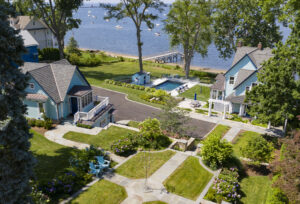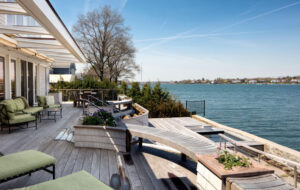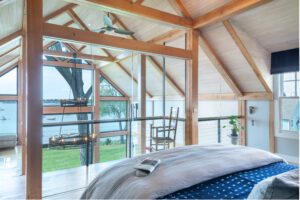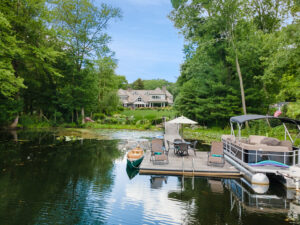Living at water’s edge
For many, a house by or on the water is a vacation. Perhaps you’ve even enjoying one this Labor Day Weekend.
But for others, a waterfront home is a dream turned year-round reality and, increasingly, a way of life.
“It’s a perennial, but it’s a rising trend at the same time,”said Robert Bruce Dean, AIA, founding principal of Robert Dean Architects LLC (RDA) in New Canaan. “People want to be at or on the water.” But with a difference.
“We’ve been in business long enough to see an evolution,” added Dean, who founded RDA on the principles of marrying the old and the new, the comfortable and the beautiful more than 30 years ago after an early career that embraced academia, the construction business and high-style design firms.
In the 1990s, people were moving from the city to the backcountry of suburbs like Greenwich and Westport. Now, he said, they’re moving from backcountry to the coast and, in the case of one Westport client, keeping both houses. It’s not necessarily about having a big estate walled off from the world either.
“All you have to do is look at Old Greenwich and Rowayton and all the activity concentrated there,” Dean said. “In Old Greenwich and Rowayton, the lots are small and pedestrian (in the sense of walkable). Everything you want is concentrated in these neighborhoods.”

Photographs by Phil Nelson for Burr Salvatore Architects.
And that is key to waterfront property. “The enduring value of landscape by the water is that it is a lifestyle by the water,” said Ryan Salvatore, AIA, who with Mary Burr, AIA, is co-founding principal of Burr Salvatore Architects PLLC, a firm based in Darien and Manhattan that uses history as a springboard for innovation. Salvatore, who worked on houses at Robert A.M. Stern Architects LLP in Manhattan and, before that, spent nearly a decade as a general contractor building custom houses and boutique offices, pointed to a compound that Burr Salvatore created for a couple on Shippan Point in Stamford. In addition to the existing house that they renovated, the sky blue and white compound includes a garage/cottage, a guest barn based on an 1860s structure that was completely reimagined, a pool house and a “spring house” to hide the air conditioning condensers.
“It encapsulates the spirit of waterfront living,” Salvatore said, which includes water sports and maritime art.
Also capturing this spirit is a 45-acre community of 13 private homes on spring-fed Blue Heron Lake in Pound Ridge, said Angela Kessel, the number one agent for Houlihan Lawrence, the top brokerage in Northern Westchester, who is handling one of the lakeside properties, valued at $6,350,000. (See sidebar.)
“It’s beautiful, clear, clean,” Kessel said. “Waterfront property has always been important, but it’s more important since Covid.”
With its “incredible views” and private access to the lake for the homeowners, a combination of weekenders and full-time residents, which is often the case of waterfront properties, the community is a “Hamptons alternative.”
Waterfront challenges
Hamptons alternatives notwithstanding, waterfront properties in general offer their challenges, chief among them being the potential for flooding. In Eric Jay Dolin’s absorbing 2020 book “A Furious Sky: The Five-Hundred-Year History of America’s Hurricanes,” he includes the story of the 1935 hurricane that movie legend Katharine Hepburn and family members in Old Saybrook, Connecticut, survived by holding on to a rope and trudging for 15 minutes in fast-moving, knee-high water to higher ground. Looking down, they watched their expansive Victorian home turn around and sail away. Eventually, Hepburn got through to her father, Thomas Hepburn, M.D. — who was in Hartford, where he was on staff at Hartford Hospital, to report that while all were safe, the house was gone. To which he replied, “I suppose you didn’t have brains enough to throw in a match before it disappeared. I’m insured for fire.”

According to the website for the Federal Emergency Management Agency (FEMA) , most homeowners insurance does not cover flooding, which can mean up to $25,000 worth of damage for just one inch of water. The FEMA-managed National Flood Insurance Program (NFIP) operates through a network of more than 50 insurance companies and the NFIP Direct. Flood insurance is available to any home or business in the almost 23,000 participating NFIP communities. Those in high-risk flood areas with mortgages from government-backed lenders are required to have flood insurance.
Not all waterfront properties are in flood zones. The lakefront community in Pound Ridge is not, Kessel said. But those that are can require all the ingenuity that an architect and a homeowner have at their disposal since, Salvatore said, “most municipalities limit what you can do to improve a house that is not flood-compliant.” Indeed, he added, sometimes it’s better just to tear down the existing structure and start from scratch.
Design solutions
Among the ways that architects make existing homes flood-compliant is to raise them up, as in the case of a Westport cottage, a 1900 oyster shack no bigger than its small, storm-tossed lot, which RDA saved by lifting the structure a full story, or roughly 7 ½ feet, out of flood risk. Working with Gallo Construction in Milford, structural engineer Mekael Engineering & Consulting LLC in New Haven and civil engineer B&B Engineering in Woodbridge, Connecticut, in a 7-foot-wide pathway between two other structures, Dean said, “we had to remove the entire foundation and place the house on freestanding concrete piers. The footings had to be excavated and constructed, with most work only occurring during low tide. The piers are covered with peddle dash stucco that includes local (oyster) shells gathered by the homeowner.”
The result yielded design delights, he added: “One of the best design discoveries was when we raised the house by a full story, we suddenly had a lovely waterside outdoor space for entertaining and access for kayaking, along with an outdoor shower and shed storage.”
Inside, he said, “rooms like the (primary) bedroom benefited from lifting the house a full story, as we were able to extend the water views to look over the adjacent beach and harbor.”

For a well-situated house in Old Greenwich, RDA lifted the structure and revamped the interior entirely, designing a deck with Bedford landscape architect Conte & Conte LLC to bridge the house and the seawall.
“The lower deck nestles up against the seawall with a hot tub right at the water’s edge,” Dean said.
Creating or recreating a house that’s up to flood-insurance codes requires a certain sleight of architectural hand. For an empty-nesters’ oasis in Rowayton, RDA worked with Norwalk’s S & W Building Remodeling Inc. to install stone veneer across the face of the exposed foundation and stone piers to support the first-floor deck, then teamed with Norwalk’s Tuliptree Site Design to use retaining walls and planting beds for a gradual transition from the driveways up to the newly elevated first floor, along with pergolas and trellises to give the facade depth.
For a house nestled between the Atlantic Ocean and Shinnecock Bay in Quogue on Long Island, Burr Salvatore Architects hid a mechanical well between two gables to comply with flood regulations inconspicuously. But Salvatore said that water isn’t the only element you have to consider. The Long Island house’s cedar roof and shingles not only pay tribute to waterfront design in the Northeast but to a material that wears well and beautifully in the salt air, as does copper, he said. (Burr Salvatore is using cedar shingles and red brick for a summer 2024 house on the Long Island Sound that will evoke Newport, Rhode Island’s shingle-style cottages.) In another of their houses on Shippan Point, built by Hobbs Inc. in New Canaan with interiors by Kennedy Leonard Design in Old Saybrook, deep porches and nautical awnings shield the west-facing water views from the late-afternoon sun.
In addition to cedar shingles, cement, stone and brick, steel is an important material in waterfront construction, said Mary Burr, who worked on houses at Robert A.M. Stern Architects and, prior to that, at the Boston firm Albert, Righter & Tittmann Architects Inc. before co-founding Burr Salvatore.
These kinds of materials and the “gingerly construction” can add roughly 25% to the cost of building/remodeling a waterfront home compared with what it would cost inland, said Robert Dean. But for him and others who create waterfront homes, and those who dwell in them, the longing for a life by the water trumps cost.
“We recognize,” Dean said, “how special it is to be at the water’s edge.”
For more, visit burrsalvatore.com and robertdeanarchitects.com.

Westchester’s answer to the Hamptons, a house on a lake
Houlihan Lawrence real estate agent Angela Kessel has said that this house on South Bedford Road in Pound Ridge is an alternative to the Hamptons.
The 6,628-square-foot Nantucket-style home is one of 13 in a private, 45-acre community anchored by spring-fed Blue Heron Lake. The crystalline water makes it ideal for swimming, boating, fishing and ice skating.
The 36-year-old house itself, on 3.19 acres featuring gardens, a dock, a pool and a pool house, has a front-to-back entry for water views.
The entry in turn leads to spacious great rooms made for both entertaining and everyday family living. The chef’s kitchen and top-of-the-line bathrooms, five full, one half, enhance the sense of a home made for weekends, summers or year-round.
A less-than-one-hour commute from New York City, the house is minutes from Scotts Corners for dining, shopping and cultural attractions, while The Henry Morgenthau Preserve on the north end of the lake affords opportunities for hiking and cross-country skiing.
The house lists for $6,350,000. For more, call Angela Kessel at 914-841-1919.